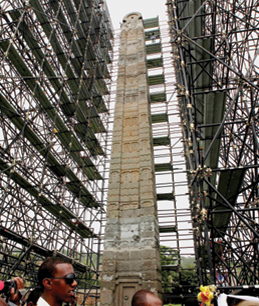
EARTH AND SKY: The Axum obelisk back where it belongs
Some archaeologists speculate that when the 80-ft. (24 m) obelisk the Axumites of ancient Ethiopia had built for their monarch collapsed, it was such a terrifying portent that the residents of the surrounding highlands abandoned their beliefs and flocked to the new religion from the Near East, giving rise to Africa's first Christian kingdom.
Today, tourists in Axum, 370 miles (600 km) north of Addis Ababa, may find a different kind of inspiration on seeing the 150-ton pillar standing tall, as intended. The granite obelisk, with false doors and windows carved in low relief, lay broken on the ground for around 1,700 years until it was carted off to Italy by occupying forces in 1937. It was returned four years ago and re-erected earlier this year — one of Africa's great ancient monuments is finally back home and in one piece.
The Axum obelisk is the latest addition to the otherworldly sites of Ethiopia's north: the island monasteries of Bahir Dar, the castles of Gonder and the churches of Lalibela, which were cut out of solid rock. And as an extra incentive to trek to the highlands, a visit to the churches and monasteries carved into the vertiginous cliffs at the mouth of the Great Rift Valley south of Axum is now made easier by the opening of the new Gheralta Lodge (www.gheraltalodgetigirai.com).
Fifteen bungalows, built to emulate the local drystone architecture (but equipped with modern amenities), look over a chessboard of small farms and slender sandstone mesas. Nearby are more than a dozen solemn churches — some perched high on the cliffs, others only a few steps from the road — attended by monks dutifully keeping the ancient Coptic traditions alive. After a day of hiking and exploring, guests at the Lodge can enjoy simple four-course meals with ingredients fresh from the garden — unpretentious enough for a monk, yet sumptuous enough for a king.